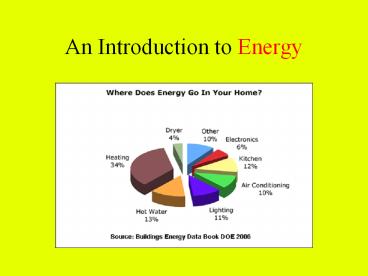An Introduction to Energy - PowerPoint PPT Presentation
Title:
An Introduction to Energy
Description:
An Introduction to Energy – PowerPoint PPT presentation
Number of Views:208
Avg rating:3.0/5.0
Title: An Introduction to Energy
1
An Introduction to Energy
2
Why do we care?
3
1. Fossil fuels are finite
- a fuel (as coal, oil, or natural gas) formed in
the earth from plant or animal remains
4
2. Demand constantly increases
5
3. Security-can we provide our own energy?
UPDATE EIA Sees U.S. Crude-Oil Output Topping
Net Imports in October http//online.wsj.com/art
icle/BT-CO-20130312-710405.html
6
Mapping U.S. Oil Imports
7
(No Transcript)
8
(No Transcript)
9
4. Pollution and Global Warming
10
5. Connection between energy costs and economic
growth
11
Where do we get our energy?
12
SOURCES OF ENERGY
13
Washington State Energy Profile
- Profile
14
(No Transcript)
15
(No Transcript)
16
Annual Per Capita Energy Consumption, Selected
Countries
8.1
4.1
4.1
2.4
1.1
0.9
0.5
China excludes Hong Kong
0.3
Per Capita Consumption of Commercial Energy (tons
of oil equivalent)
17
The US as Energy User
- Link
18
How we USE energy
19
HOW WE USE ENERGY
Transportation (fossil fuels) 28
20
Rise of the Private Car
21
Energy That Moves Us
Transportation The worlds fastest growing form
of energy use, largely due to the rise of the
private car
22
US New CAFE standards
- CAFE stands for corporate average fuel economy
- Average mpg of a company's fleet
23
Cars in China
- Oil consumption increases 7.5 a year (7x US)
- 90x more cars today than in 1990
- More cars than US by 2030
24
(No Transcript)
25
Indias Nano (peoples car) 2500 new
26
HOW WE USE ENERGY
Household (electricity) 22
27
Energy Where We Live and Work
- Building Trends
- Energy use in buildings is rising rapidly
- International Energy Agency predicts that world
electricity demand will double between 2000 and
2030, with most rapid growth in peoples homes
28
Household Trends
29
HOW WE USE ENERGY
Commercial 19
30
HOW WE USE ENERGY industry 31
- These 6 industries use most
- Petroleum refining
- Steel manuf.
- Aluminum manuf.
- Paper manuf.
- Chemical manuf.
- Cement manuf.
31
Energy in Everything We Buy
- Manufacturing
- Largest share of global energy use goes to
manufacturing our vehicles, buildings,
appliances, and even our food and clothes - Embodied energy energy invested in a particular
thing during its lifetime, from cradle to grave
- Much of the energy embodied in an item is that
required to produce it
32
Embodied Energy
33
HOW WE USE ENERGY
Agriculture (fossil fuels)
34
How we USE energy
- What type of energy is used in each sector?
- How would the type of energy used impact the
possible solutions?
35
SOME DEFINITIONS
36
ELECTRICITY
- Electricity is a secondary source
- We must convert a primary source into electricity
(coal, oil, natural gas, solar)
37
How to convert to Electricity
an electrical current is generated in a conductor
moving in a magnetic field. The effect is greatly
magnified if the conductor is replaced with a
coil or coils of copper wire. If these coils are
mounted on a rotating shaft or armature,
continuous rotation will produce a continuous
alternating electrical current. This is how
nearly all electricity is generated today.
38
Kilowatt Hour
- A unit of energy commonly used on fuel bills.
- One kWh would power a device that consumes a
kilowatt of power for an hour, or a 100 watt
lightbulb for 10 hours, etc.
39
(No Transcript)
40
THE GRID
- Power distribution network
- Connects power generation plant to the plug in
your house
41
Off the Grid
- Self-sufficient
- Generate your own power
- No connection to grid
42
Net-metering
- Generate some power
- When not using, power returns to grid
- Power company pays you for this power
43
Baseload Power
- Power available at all times
- Baseload power plants run constantly and generate
the minimum constant demand - Some alternatives not appropriate for baseload
44
Renewable Energy
- Unlike fossil fuels, which are exhaustible,
renewable energy sources regenerate and can be
sustained indefinitely. The five renewable
sources used most often are biomass, water
(hydropower), geothermal, wind, and solar.
45
SOLUTIONS
- Decrease use
- Increase/change source
46
Options and Solutions
Conservation (lose less)
47
Options and Solutions
Efficiency (use less)
48
Options and Solutions
Switch to new sources































